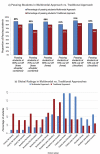A structured multimodal teaching approach enhancing musculoskeletal physical examination skills among undergraduate medical students
- PMID: 35993497
- PMCID: PMC9466621
- DOI: 10.1080/10872981.2022.2114134
A structured multimodal teaching approach enhancing musculoskeletal physical examination skills among undergraduate medical students
Abstract
Current evidence indicates that undergraduate medical students display deficits in musculoskeletal physical examination skills (MPES). While various instructional methods are recommended for teaching clinical skills, effective methods for teaching MPES have not been established. This study compared the effectiveness of a multimodal teaching approach incorporating video-based learning, interactive small-group teaching, hands-on practicing, peer-assisted learning, formative assessment, and constructive feedback with traditional bedside teaching in developing undergraduate orthopedic MPES. Participants were 151 fifth-year medical students divided into two groups. One group received multimodal teaching, and the other received traditional bedside teaching. In both groups, the participants learned how to physically examine the knee and shoulder. The primary outcome was objective structured clinical examination (OSCE) scores, while the secondary outcomes included teaching sessions' total durations, facilitator's demonstration time, participants' practice time, and proportion of students with passing checklist scores and global ratings-based assessments for the two teaching approaches. The multimodal teaching group had significantly higher OSCE scores (checklist scores, global ratings, and passing rates; p = 0.02, 0.02, 0.01, respectively) than the comparison group. Individual OSCE component assessments showed significant improvements in the special musculoskeletal physical examination test. The overall duration and amount of participants' hands-on time were significantly longer for the multimodal than for the traditional bedside teaching group (p = 0.01 and 0.01, respectively), and the facilitator's demonstration time was significantly shorter (p = 0.01). The multimodal learner-centered teaching approach evaluated in this study was effective for teaching MPES. It appeared to maximize learner engagement through enhancing interactions and providing increased time to engage in hands-on practice. This teaching approach improved MPES levels, maximized teaching efficiency for scenarios with limited instruction time and resources, and enhanced competency of undergraduate medical students in performing special musculoskeletal physical examinations compared to traditional bedside teaching.
Keywords: Multimodal teaching; musculoskeletal; peer-assisted learning; physical examination skills; undergraduate; video-based learning.
Conflict of interest statement
No potential conflict of interest was reported by the author(s).
Figures



Similar articles
-
Undergraduate Clinical Teaching in Orthopedic Surgery: A Randomized Control Trial Comparing the Effect of Case-Based Teaching and Bedside Teaching on Musculoskeletal OSCE Performance.J Surg Educ. 2018 Jan-Feb;75(1):132-139. doi: 10.1016/j.jsurg.2017.06.024. Epub 2017 Jul 15. J Surg Educ. 2018. PMID: 28720423 Clinical Trial.
-
Teaching clinical skills in musculoskeletal medicine: the use of structured clinical instruction modules.J Rheumatol. 2002 Apr;29(4):813-7. J Rheumatol. 2002. PMID: 11950026
-
A randomised controlled trial study on the effectiveness of high-fidelity simulation in enhancing skills among undergraduate medical students.Med J Malaysia. 2024 Jul;79(4):421-428. Med J Malaysia. 2024. PMID: 39086339 Clinical Trial.
-
Changing an existing OSCE to a teaching tool: the making of a teaching OSCE.Acad Med. 2002 Sep;77(9):932. doi: 10.1097/00001888-200209000-00036. Acad Med. 2002. PMID: 12228103 Review.
-
Clinical skills training in undergraduate medical education using a student-centered approach.Dan Med J. 2013 Aug;60(8):B4690. Dan Med J. 2013. PMID: 23905573 Review.
Cited by
-
A Course-Specific Video-Based Laboratory Manual for Training Doctor of Physical Therapy Students in Orthopedic Clinical Examination and Intervention Skills: Perceptions and Preliminary Results.Med Sci Educ. 2022 Nov 23;33(1):15-19. doi: 10.1007/s40670-022-01687-7. eCollection 2023 Feb. Med Sci Educ. 2022. PMID: 37008447 Free PMC article.
-
An activity theory approach to analysing student learning of human anatomy using a 3D-printed model and a digital resource.BMC Med Educ. 2025 Apr 16;25(1):553. doi: 10.1186/s12909-025-07172-0. BMC Med Educ. 2025. PMID: 40241140 Free PMC article.
-
To Develop and Implement a Preclinical Operative Dentistry Module to Enhance Class-II Cavity Preparation Training.Int J Appl Basic Med Res. 2024 Oct-Dec;14(4):273-277. doi: 10.4103/ijabmr.ijabmr_257_24. Epub 2024 Nov 1. Int J Appl Basic Med Res. 2024. PMID: 39749168 Free PMC article.
-
The use of 360-videos to bridge the gap between pre-clinical and clinical dental teaching.BMC Med Educ. 2025 Mar 13;25(1):375. doi: 10.1186/s12909-025-06946-w. BMC Med Educ. 2025. PMID: 40075369 Free PMC article.
References
-
- Hauer KE, Teherani A, Kerr KM, et al. Student performance problems in medical school clinical skills assessments. Acad Med. 2007. Oct;82(10 Suppl):S69–72. PMID: 17895695 - PubMed
MeSH terms
LinkOut - more resources
Full Text Sources
